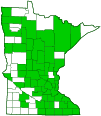paleleaf woodland sunflower
(Helianthus strumosus)
Conservation • Wetland • Description • Habitat • Ecology • Use • Distribution • Taxonomy
Description |
Paleleaf woodland sunflower is a 24″ to 72″ tall, erect, perennial forb that rises from a long-creeping rhizome. The rhizome is branched and has tubers at the tips of the branches. It usually forms dense colonies. The stems are erect and usually solitary, though they sometimes appear in small clumps. They are hairless or sparsely hairy below the inflorescence and are often somewhat covered with a whitish, waxy coating (glaucous). There are usually 8 to 20 pairs of opposite leaves. Sometimes the leaves near the top of the stem are alternate. The larger leaves are on ⅜″ to 1⅛″ long leaf stalks The leaf blades are relatively thick, firm, lance-shaped to narrowly egg-shaped, and flat, not folded longitudinally. They are 2¾″ to 7″ long and ¾″ to 4″ wide, 2 to 5 times as long as wide. They are wedge-shaped to almost heart-shaped at the base, and taper to a sharp point at the tip with slightly convex sides along the tip. The upper surface is rough with minute hairs that have a small bump at their base. The lower surface is usually sparsely to densely hairy with soft hairs, but may be hairless or almost hairless and pale green to silvery. The margins are shallowly toothed to untoothed. The leaves have 3 main veins, a midvein and a pair of lateral veins that branch off the main vein just above the base and arch upward. There are also several less prominent lateral veins. The inflorescence is 3 to 15 flower heads appearing as a single head at the end of the stem and few-headed clusters from the upper leaf axils. The flower heads are 1½″ to 4″ wide. There are 8 to 15 yellow ray florets and 35 or more yellow disk florets. The tips of the bracts that form the involucre spread outwards. The fruit is an achene. |
Height |
24″ to 72″ |
Flower Color |
Yellow ray florets, yellow disk florets |
Similar Species |
Woodland sunflower (Helianthus divaricatus) leaves are stalkless or on leaf stalks less than 3 ⁄16″ long. It does not occur in Minnesota. |
Habitat |
Dry to moderate moisture. Bottomland forests, upland forests, stream banks, river banks, railroads, roadsides. Full to partial sun. |
Ecology |
Flowering |
July to October |
Pests and Diseases |
Sunflower bullet gall midge (Pilodiplosis helianthibulla) makes ¼″ in diameter, almost globe-shaped galls on the leaves of plants in the genus Helianthus. |
Use |
|
Distribution |
||
|
Sources |
|
| 5/24/2023 | ||
Nativity |
||
Native |
||
Occurrence |
||
|
||
Taxonomy |
|
Kingdom |
|
Subkingdom |
Pteridobiotina |
Phylum |
Tracheophyta (Vascular Plants) |
Class |
|
Order |
Asterales (Sunflowers, Bellflowers, Fanflowers, and Allies) |
Family |
Asteraceae (Sunflowers, Daisies, Asters, and Allies) |
Subfamily |
Asteroideae |
Tribe |
Heliantheae (Sunflowers and Allies) |
Subtribe |
Helianthinae |
Genus |
Helianthus (sunflowers) |
Subordinate Taxa |
|
|
|
Synonyms |
|
Helianthus montanus Helianthus saxicola |
|
Common Names |
|
pale-leaved woodland sunflower paleleaf woodland sunflower rough-leaved sunflower swollen sunflower woodland sunflower |
|
Glossary
Bract
Modified leaf at the base of a flower stalk, flower cluster, or inflorescence.
Glaucous
Pale green or bluish gray due to a whitish, powdery or waxy film, as on a plum or a grape.
Involucre
A whorl of bracts beneath or surrounding a flower, flower head, or flower cluster.
Rhizome
A horizontal, usually underground stem. It serves as a reproductive structure, producing roots below and shoots above at the nodes.
Tuber
An underground root (as with dahlias) or stem (as with potatoes), thickened by the accumulation of reserved food (usually starch), which serves for food storage and vegetative propagation.
Visitor Photos |
||
Share your photo of this plant. |
||
This button not working for you? |
||
|
||
MinnesotaSeasons.com Photos |
||
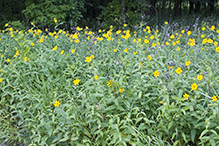 |
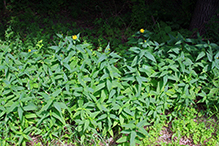 |
|
Habitat |
Habitat |
|
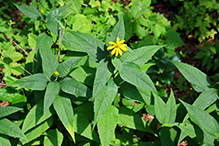 |
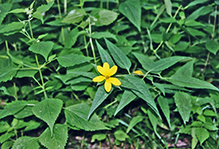 |
|
Plant |
Plant |
|
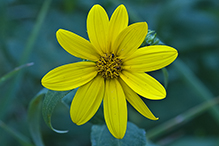 |
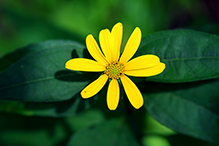 |
|
Flower head |
Flower head |
|
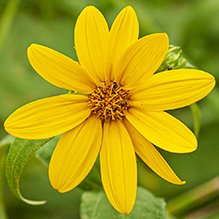 |
||
Flower head |
|

Slideshows |
|

Visitor Videos |
||
Share your video of this plant. |
||
This button not working for you? |
||
|
Other Videos |
||
helianthus strumosus |
About
Uploaded on Aug 22, 2011 helianthus strumosus |

Visitor Sightings |
||
Report a sighting of this plant. |
||
This button not working for you? |
||
|
|
MinnesotaSeasons.com Sightings |
||

|
Created: 8/14/2004 Last Updated: © MinnesotaSeasons.com. All rights reserved. |
